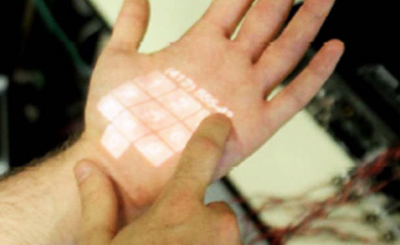Keyboards and mice are so '99. The interface of the future will be your own body.
 Kinect's 'using your body as a controller' feature was one of technology’s big hits last year--not only have users had fun dancing up a storm and racing cars with official Kinect games, but a whole community has emerged to dream up new and inventive ways of hacking the system that tracks 20 joints in your body.
Kinect's 'using your body as a controller' feature was one of technology’s big hits last year--not only have users had fun dancing up a storm and racing cars with official Kinect games, but a whole community has emerged to dream up new and inventive ways of hacking the system that tracks 20 joints in your body.
But if you think that's Microsoft's last foray into unconventional means of controlling digital devices, think again. The Seattle giant has a whole team of smarty-pants researchers tasked with imagining new and freaky ways we might one day turn on our mp3 players, dial phones, and, who knows, maybe even power up a microwave for a little burrito action.
One of the projects they’re working on is 'Skinput,' a system that would allow you to control devices simply by hitting specific points on your arm. Not a device on your arm. Just your arm itself.
Here’s one way you might use it: You’re on your usual early-morning jog. Your mp3 player is set to “shuffle.” A song comes up that you’ve heard one too many times. Instead of having to stop your run, take out your player, and fumble with the buttons or spin wheel to skip to the next song, you just hit your arm about midway up and keep on cruising.
The idea behind Skinput is that mechanical vibrations travel differently through your bodydepending on where they originate. Or, as the robotic voice in the video below explains: “Variations in bone density, size and mass, as well as filtering effects from soft tissues and joints, mean different locations are acoustically distinct.” The Skinput team is developing software that would listen for the vibrations--through, for example, an armband on your bicep--and then turn them into instructions for a particular device.
[youtube MUnvdblJhP8]
Another Microsoft team is looking not at mechanical vibrations but instead at the electric signals your muscles create when they contract. One of the researchers on that project, Scott Saponas, tells Fast Company about a use case drawn from his own experience. In his spare time, Saponas takes pottery classes. It’s not unusual for someone to call him while his hands are covered in clay. What if instead of racing to clean your hands before your caller hangs up--or, worse, missing a call altogether--you could simply answer your phone by touching your thumb and forefinger together, for example?
The researchers are looking into how an armband with sensors on it, similarly affixed to your arm, could pick up the electric signals given off by different gestures and use that as a control mechanism. In the video below, Saponas shows how he hacked Guitar Hero to take input from the muscles he uses to strum an imaginary guitar.
[youtube pktVSTwC8qo]
Both of these projects are still in the research phase, and it would be at least five years before either could conceivably make it to the marketplace. And there's no guarantee that either actually will make it to market, says Saponas. But something will. Keyboards and mice work just fine when the only place you're doing computing is at your desk. But as we increasingly use digital devices in our everyday lives, especially in situations when our hands are otherwise occupied, like at the gym, in the grocery store, or while driving, it’s certain that we will be using interfaces like these, or similar ones, not too far down the line.
[Image: Microsoft]
Follow Fast Company on Twitter.
E.B. Boyd is FastCompany.com's Silicon Valley reporter. Twitter. Email.

No comments:
Post a Comment